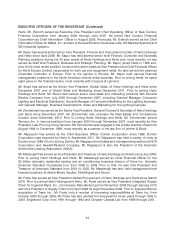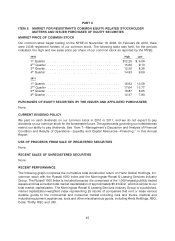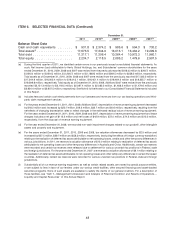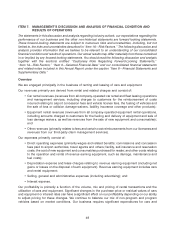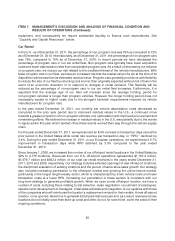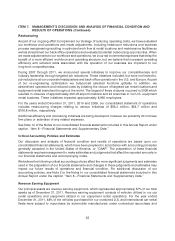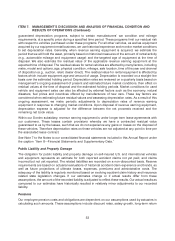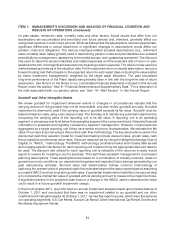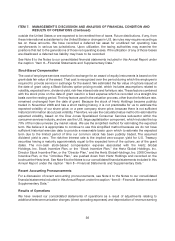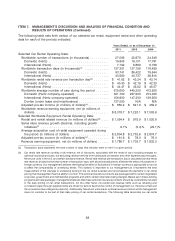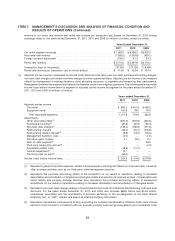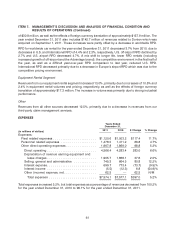Hertz 2011 Annual Report Download - page 80
Download and view the complete annual report
Please find page 80 of the 2011 Hertz annual report below. You can navigate through the pages in the report by either clicking on the pages listed below, or by using the keyword search tool below to find specific information within the annual report.ITEM 7. MANAGEMENT’S DISCUSSION AND ANALYSIS OF FINANCIAL CONDITION AND
RESULTS OF OPERATIONS (Continued)
on plan assets, retirement rates, mortality rates and other factors. Actual results that differ from our
assumptions are accumulated and amortized over future periods and, therefore, generally affect our
recognized expense in such future periods. While we believe that the assumptions used are appropriate,
significant differences in actual experience or significant changes in assumptions would affect our
pension costs and obligations. The various employee-related actuarial assumptions (e.g., retirement
rates, mortality rates, salary growth) used in determining pension costs and plan liabilities are reviewed
periodically by management, assisted by the enrolled actuary, and updated as warranted. The discount
rate used to value the pension liabilities and related expenses and the expected rate of return on plan
assets are the two most significant assumptions impacting pension expense. The discount rate used is a
market-based spot rate as of the valuation date. For the expected return on assets assumption, we use a
forward-looking rate that is based on the expected return for each asset class (including the value added
by active investment management), weighted by the target asset allocation. The past annualized
long-term performance of the Plans’ assets has generally been in line with the long-term rate of return
assumption. See Note 5 to the Notes to our consolidated financial statements included in this Annual
Report under the caption ‘‘Item 8—Financial Statements and Supplementary Data.’’ For a discussion of
the risks associated with our pension plans, see ‘‘Item 1A—Risk Factors’’ in this Annual Report.
Goodwill and Other Intangible Assets
We review goodwill for impairment whenever events or changes in circumstances indicate that the
carrying amount of the goodwill may not be recoverable, and also review goodwill annually. Goodwill
impairment is deemed to exist if the carrying value of goodwill exceeds its fair value. Goodwill must be
tested at least annually using a two-step process. The first step is to identify any potential impairment by
comparing the carrying value of the reporting unit to its fair value. A reporting unit is an operating
segment or a business one level below that operating segment (the component level) if discrete financial
information is prepared and regularly reviewed by segment management. However, components are
aggregated as a single reporting unit if they have similar economic characteristics. We estimate the fair
value of our reporting units using a discounted cash flow methodology. The key assumptions used in the
discounted cash flow valuation model for impairment testing include discount rates, growth rates, cash
flow projections and terminal value rates. Discount rates are set by using the Weighted Average Cost of
Capital, or ‘‘WACC,’’ methodology. The WACC methodology considers market and industry data as well
as Company-specific risk factors for each reporting unit in determining the appropriate discount rates to
be used. The discount rate utilized for each reporting unit is indicative of the return an investor would
expect to receive for investing in such a business. The cash flows represent management’s most recent
planning assumptions. These assumptions are based on a combination of industry outlooks, views on
general economic conditions, our expected pricing plans and expected future savings generated by our
past restructuring activities. Terminal value rate determination follows common methodology of
capturing the present value of perpetual cash flow estimates beyond the last projected period assuming
a constant WACC and low long-term growth rates. If a potential impairment is identified, the second step
is to compare the implied fair value of goodwill with its carrying amount to measure the impairment loss.
A significant decline in the projected cash flows or a change in the WACC used to determine fair value
could result in a future goodwill impairment charge.
In the fourth quarter 2011, we performed our annual impairment analysis based upon market data as of
October 1, 2011 and concluded that there was no impairment related to our goodwill and our other
indefinite-lived intangible assets. At October 1, 2011, we had five reporting units, which were the same as
our operating segments: U.S. Car Rental, Europe Car Rental, Other International Car Rental, Donlen and
Worldwide Equipment Rental.
54


